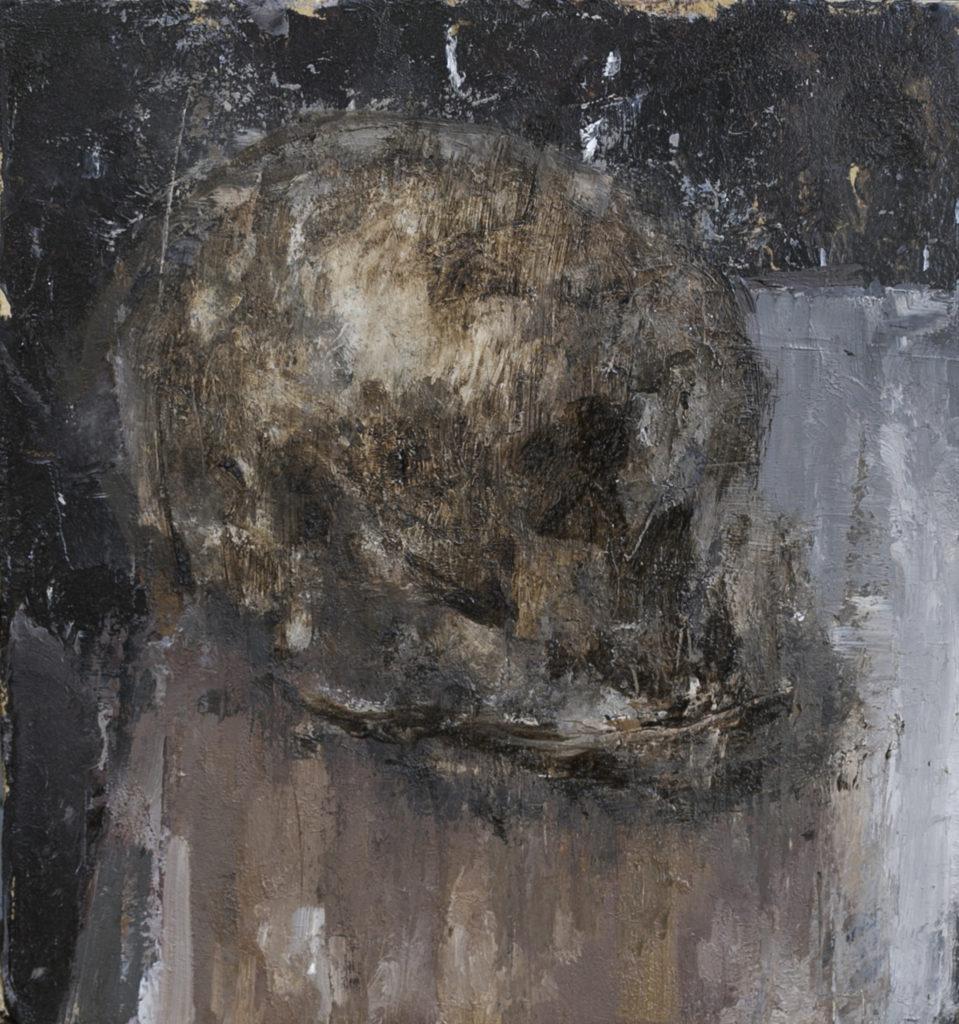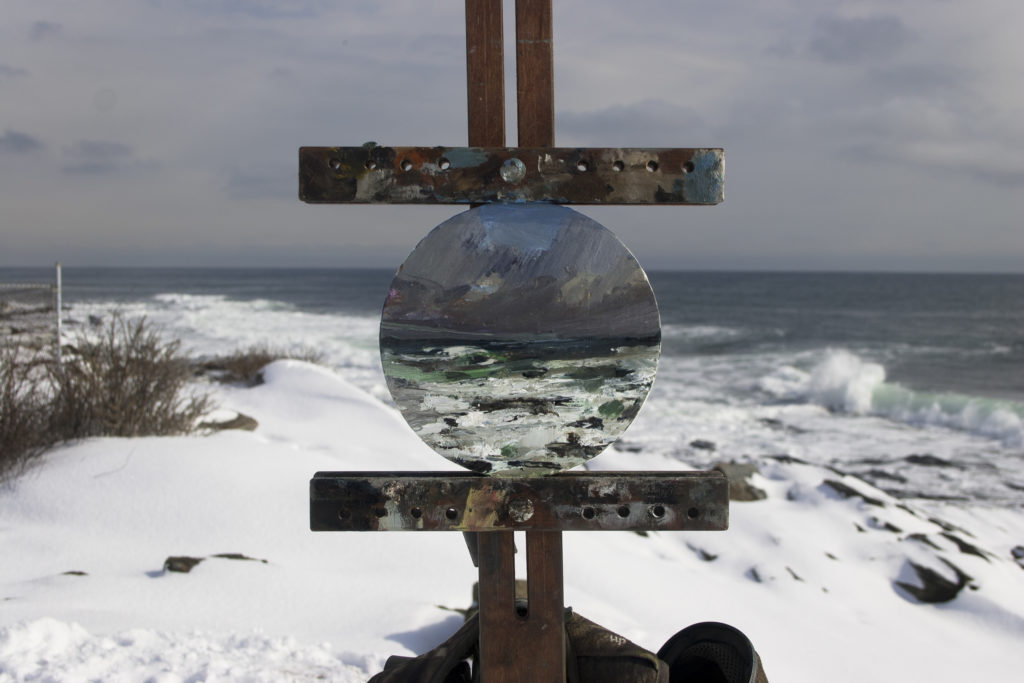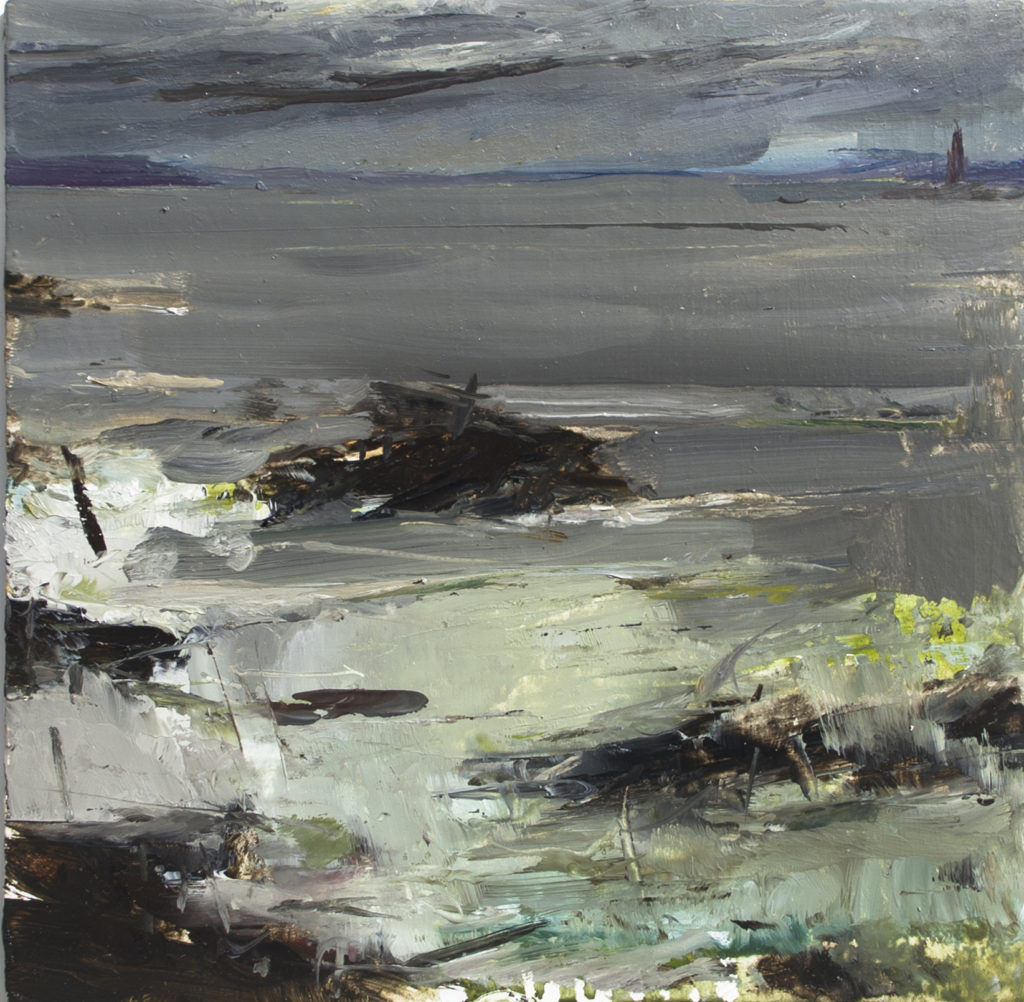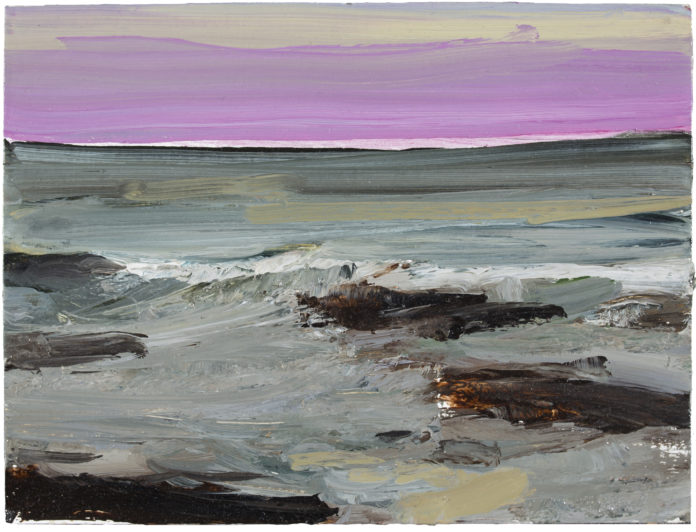From inside the artist’s mind – an article by Timothy Wilson on the art of painting.
BY TIMOTHY WILSON
Constable believed that the Painter does not receive illuminations, but rather makes discoveries. It is the job of the Painter (perhaps one of many) to not just describe what something is, but how something is. In order to do so, we need to experience things to create a visual vocabulary from which we pull. In a moment of pure desperation last year, I took a makeshift easel to the ocean in an attempt to vent my never-ending frustrations in the studio; and suddenly found myself captivated by a form of painting that has completely, and dramatically, affected my entire philosophy and approach to painting and life.
The Importance of Experience
Everything naturally exists in a dimension of time. In a still frame or photograph, everything is equal. Everything is frozen. When we spend time studying an object or setting in person, we are exposed to the different mortalities of things. Everything dies at different rates, so in experiencing something in real life, we are progressing through time (dying) together, and thereby creating a more dynamic bond than just using photographic reference. As Painters, we take that tactile experience and push those unique intricacies to redefine how that Something can exist beyond its literal interpretation. We don’t need to use all of the information we get, just the essentials.
Below is an image that I painted using a porcupine skull I found washed clean in a river, and through a little trial and error I managed to somehow make it a bit more reminiscent of a human. I painted it on rough paper that I shellacked to a panel. I glued canvas to a panel using hide glue, and then traditionally gessoed the canvas. I always find I get a closer bond and perhaps a more interesting image when I spend the extra energy preparing my own supports and materials. There is an added weight to it.

As we interpret visual information into our artwork, the descriptions may get lost or deconstructed into abstraction.
A viewer may not be able to place why they find an image compelling, but if we as Painters are truly able to empathize and relate to the ineffable makeup of our inspiration, whatever image occurs will have the sensory details needed so that the viewer can subconsciously relate to it without hesitation.
In other words: in order to output something unique, we need to first input something of importance. Prior to the past year, one could relate my approach to painting as beating my head against various walls to see which one would give the best dent. It wasn’t the most appealing approach. I locked myself away in the studio at all hours, trying to somehow get whispers of images from the back of my head out onto a canvas. I was a figurative and portrait artist painting without figures and portraits at my aid.
After each failed approach, I would make myself stay in the studio longer, usually half sleeping in the corner instead of going home, so I could get up first thing and try to redeem myself. I was too obsessed, and put too much pressure on having to create. Painting was a completely selfish act that was taking over my life in negative way: it was costing me close relationships and physical well-being. I wasn’t allowing myself to work from reference, and suddenly was giving up sketching altogether. Instead, I would just spend hours looking at a blank canvas before attacking it.
Those attacks usually failed. My work became almost completely gray, almost completely null of tone, and almost completely formless. Although I liked some of what I produced, it just wasn’t worth the mental anguish to produce it. I was trying to subvert Constable’s notion. I was pounding my head trying to make illuminations happen without venturing out to make my own discoveries. I wasn’t even allowing myself the enjoyment of nature because it wasn’t immediately “productive.” For me, studio painting was the only option. “Plein air” painting was something on hospital walls.
Going in to the out
One day something popped; rather, I may have finally bored my head through that wall: I had to get out of my studio. I found myself screwing a camera bracket to the bottom of a tabletop easel and driving out to the ocean to paint. I wasn’t even thinking; I just acted on impulse. I had to get outside and break down the proverbial studio walls. Suddenly, my hesitations and frustrations were gone. I was just standing there smelling the salt air, mushing paint around as waves crashed all around me. I was being productive; I was enjoying something, and being soothed by my surroundings simultaneously: I was finally making a discovery.
The painting was absolutely horrible. I didn’t know what I was doing but I absolutely loved the sensation. I bundled up and went out the next day, and the next. I didn’t care that it was the middle of winter and a blizzard was bearing down. I just had to go out and paint, and experience the sensations of the cold and the ferocity of the storm. The paintings weren’t much better, yet somehow the people I showed the work to could tell that I was enjoying it, and that enjoyment seeped through the paint and helped them enjoy the painting as well.
Almost overnight painting went from a laborious torture to a meditative passion. I now wake up to strap on my gear and set out for something that catches my eye. I go on a hunt, and the hunt is always rewarding.
The Sea
However, of all the elements that inspire, I have found the ocean to be the most intoxicating. It is a purity of expressionistic being. The ocean, like Constable and his skies, is an artistic anomaly. Waves are a climactic complexity of rippling form, color changes, light, shadow, form and volume all surging towards you . . . and in the blink of an eye it’s gone. The form of the wave literally explodes, or sinks into nothingness.
For me, it is an impossible thing to capture. So, just like the still frame that renders everything in equal mortality, I have never tried to “freeze” a particular moment. I just study the movement and try to make my marks as expressive as the movement: capturing the broad sense of scale, tone, color. There are certainly painters who are able to render a scene and still manage to capture the energy of a moment. When done correctly, the result is staggeringly beautiful—something I have yet to do.
 When I approach my larger compositions, rather than try to zero in on details I tend to rely more on reaction. I layer and scumble things, and as moments emerge I try to work with what happens and embrace the textures and slight color variations that I otherwise would never be able to control. The painting below dramatically changed form every time I worked on it, until it finally just felt done.
When I approach my larger compositions, rather than try to zero in on details I tend to rely more on reaction. I layer and scumble things, and as moments emerge I try to work with what happens and embrace the textures and slight color variations that I otherwise would never be able to control. The painting below dramatically changed form every time I worked on it, until it finally just felt done.

Rather than always employing a brush, I use materials that lend themselves to a more tactile expression. Palette knives, squeegees and ink rollers are all amazing for redefining the mass of an image in a mere pull of the wrist. Sometimes I sprinkle sand in to get the paint a bit more coarse. Sometimes I drop the painting after two hours of working on it and decide to obliterate it and try again. Sometimes, when I forget materials, I forage for natural receptacles to put my mediums in (crab shells and seashells are perfect!).
Whatever happens, it’s just about the experience and pulling from what is around me. It’s not about minutely rendering the gradated crest of a wave, or the terminating shadow on a leaf stem, it’s about trying to find a way of saying “holy shit.”
Just like the egg that needs to be hatched, you need to spend time with a painting to make it fully realized. It doesn’t mean you need to sit on it hour after hour, day after day. In doing so you may squeeze the life out of it. Painters are in control of how much information is imparted. Certainly when you have an innate ability or flair for paint it is enticing to show it, but sometimes less is more. There is something to be said about the confident strokes of Sargent in which an entire feature is defined in a single motion.
Compare that to the panels of Van Eyck in which every detail is rendered. There is no natural focus as everything is microscopic in detail yet within a telescopic all-encompassing composition. Obviously each is masterful. And furthermore, I can never come close to replicating either! But in viewing them in a contemporary setting, one expresses energy through mark making and embraces the viewer, while the other almost takes the energy away from the viewer and combusts itself into a black hole.
I try to walk a balance in the middle when possible. The study below didn’t take very long, and although perhaps viewed from afar it might capture the scene, when you get up close it all falls apart into little energetic bits that somehow emulate details.

My entire philosophy has been changed by painting on location—the experience of place, the sensation of direct painting and having a confidence to venture out beyond the dimly lit studio and embrace abstraction, color, and light. My daily studies have become a sense of calm for me, an essential meditation that helps me focus and think. A year earlier I was living in fear of making art. I now spend most of my days yearning to get into the studio to work on larger compositions, but can’t seem to stop painting out in the wild, making discoveries. Constable was right.
Learn more about Timothy at: www.timothypowerswilson.com
> Visit EricRhoads.com to learn about more opportunities for artists and art collectors, including retreats, international art trips, art conventions, and more.
> Sign up to receive Fine Art Today, our free weekly e-newsletter
> Subscribe to Fine Art Connoisseur magazine, so you never miss an issue









I cannot see the paintings,why?
Hello! I’m not sure why, except maybe it’s your internet connection? Perhaps try a different browser (Firefox or Chrome), or a laptop vs phone?
Love all of these paintings by Timothy Wilson, but especially enjoyed this article! So well written and articulates precisely the frustrations and eventual joys of an artist finding their way artistically. I’m at that very point of frustration right now, and this article is spot on with sage advice on how (and why) to stick with it and stay your course…on your own path. Find your way; the one that only you know and can convey to the world in a way that no one else can, whether it be with paint, sculpture, words, theater, etc. We all have a unique “voice” that, when discovered and cultivated, can bring such value, enrichment and even joy to others. Keep digging creatively until you find your gold!